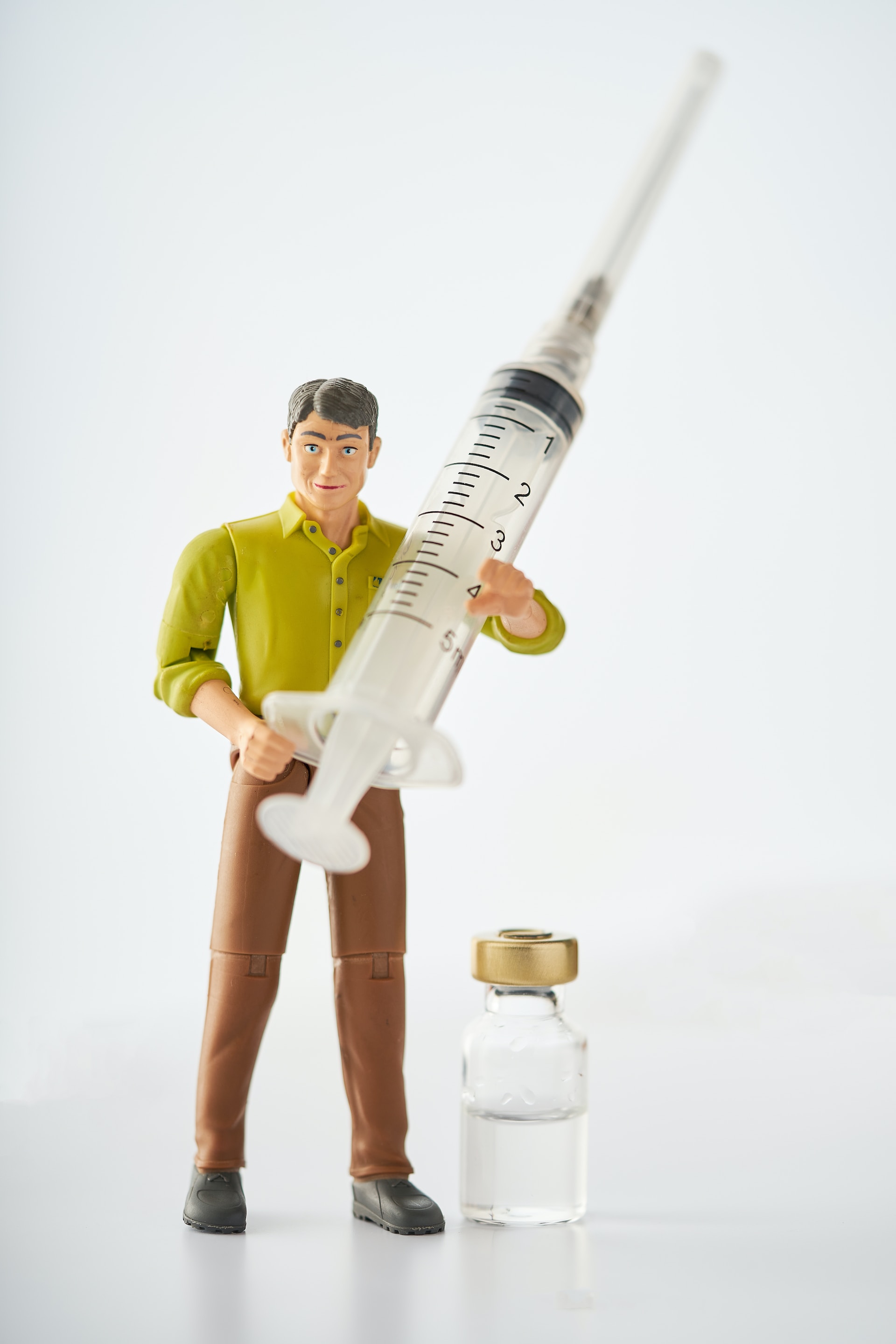
Source: Unsplash
What is testosterone and why do men need it?
Testosterone is the quintessential male sex hormone. It is produced by the testicles, enters the bloodstream and travels throughout the body to exert its effects on a multitude of organs including the brain, muscle, bone and penis. Testosterone plays a role in sexual function, sperm production, energy levels, mood, bone health and body composition. Testosterone is essential for mental and physical health.
Is a testosterone level part of routine blood work when I visit the doctor?
No. Testosterone and other sex hormones are not typically measured on routine blood work when you go to the doctor. Testosterone levels are generally obtained only when men are complaining of symptoms consistent with testosterone deficiency.

Source: Unsplash
What happens when testosterone levels fall below normal?
If testosterone levels decrease outside of the normal range, men can experience symptoms of testosterone deficiency. These symptoms may include sexual issues such as low libido and erectile dysfunction. Non-sexual symptoms may include low energy levels, lack of motivation, a depressed mood, irritability, poor concentration, insomnia, weight gain, reduced exercise endurance and difficulty building muscle mass. These symptoms can be reversed with testosterone replacement therapy or TRT.
If you have symptoms of low T you must convey these to a medical expert. Doctors should NOT be telling men to ignore any of the symptoms of low testosterone. The symptoms of low T warrant a full medical evaluation, period. Low testosterone is NOT a normal part of aging. There is no age requirement to qualify for testing. While the incidence of low testosterone increases with age, men of any age can have testosterone deficiency. If the symptoms are present, a medical evaluation should ensue.
If you have symptoms of low testosterone what should you do next?
If you are experiencing any of the symptoms of low testosterone you should speak to a medical expert. The true expert doctors in the field of low testosterone are urologists and endocrinologists. They will listen to your symptoms and perform a complete physical examination followed by lab tests. The lab testing should include at least two separate measurements of both free and total testosterone. If you have symptoms of low testosterone and low T levels on blood tests you can ask your physician to prescribe TRT.
Do NOT settle for another type of medical doctor if you are concerned about low testosterone and seeking medical evaluation. Beware of men’s health clinics and online testosterone clinics staffed by unethical medical professionals with absolutely no training in the field. The testosterone industry is full of quacks claiming to be hormone experts. Any medical provider with a prescription pad can write a testosterone prescription. But writing a prescription for a powerful sex hormone is not the same as being a medical expert in testosterone use.
At what testosterone level will a doctor prescribe testosterone?
Normal total testosterone values usually range from 300-1,000 ng/dL while normal free testosterone falls between 50-225 pg/mL. If your testosterone levels are below the normal range on two blood tests you have strong biochemical evidence of low testosterone and testosterone therapy is indicated. Some men with “low normal” T levels may still benefit from therapy.
Patients who have bothersome symptoms of low testosterone but fall within the lower end of the normal reference range may still be good candidates for TRT. Normal does not necessarily mean optimal. However, if testosterone levels are quite good then testosterone therapy is not indicated. Other causes for the symptoms should be explored.
What are the next steps once I am diagnosed with low testosterone?

Source: Unsplash
Once a medical expert identifies low testosterone levels they will look for an underlying cause or medical condition that could be impairing the body’s ability to produce testosterone. The medical history, medical examination and lab tests will sort this out. If an underlying medical issue is found the doctor will deal with it accordingly in order to normalize testosterone production.
If no underlying medical issue is found by your doctor, a treatment plan will be discussed to include a detailed conversation about the benefits and risks of testosterone therapy. This is a vital part of any men’s health evaluation for low testosterone. Men must be well informed about the risks of hormone therapy before starting treatment. The treatment for low testosterone is testosterone replacement therapy to restore normal testosterone levels.
What are the benefits of testosterone therapy?
Bringing T levels into the normal range with testosterone products can improve sexual function, energy levels, motivation, concentration, sleep, sense of vitality and mood. TRT therapy also has a profound effect on body composition so it helps men build muscle and burn fat. It can also have health benefits to include improved bone health and insulin sensitivity.
What are the risks of taking TRT?
The risks of testosterone therapy or TRT include low sperm count, worsening sleep apnea, fluid retention, high estrogen levels, increased red blood cell count and blood clots. In rare cases it may increase blood pressure or cholesterol. Testosterone therapy does not increase the risk of prostate cancer but it may accelerate the lethality of some prostate malignancies. Testosterone replacement does not increase the risk of cardiovascular events such as heart attack or stroke although it may increase the risk of venous blood clots and atrial fibrillation.
What are the treatment options for testosterone deficiency?
The most common treatment for testosterone deficiency is the administration of synthetic testosterone, a controlled substance. All modern testosterone preparations contain the same high quality testosterone. There are several FDA approved treatment options including oral testosterone, nasal testosterone, topical gels and creams, short and long acting testosterone injections as well as implantable testosterone pellets.All testosterone is “bioidentical” so do not be fooled by quacks claiming to have some unique formulation of “bioidentical” hormones to sell you.

Source: Unsplash
What is the most effective treatment for low testosterone?
Any modern FDA approved treatments for low testosterone can be effective when prescribed skillfully by a medical expert. Usually the choice of drug will depend on patient preference and cost. One of the more popular testosterone prescriptions is short acting testosterone injections which are typically self administered once or twice a week into the muscle or subcutaneous fat. But, for those men who don’t like needles other testosterone medications will work just fine.
What will my testosterone level be on treatment?
In general, the goal of testosterone therapy is to restore normal testosterone levels in the blood. Ultimately, this should lead to improvement in the clinical symptoms of testosterone deficiency. Most experts bring the testosterone level into the mid-normal range (600-700 ng/dL) during treatment. However, symptom control should always be factored into treatment decisions.
Testosterone is just a number. The symptoms the patient is suffering with are equally, if not more important. Some men require more testosterone than others to achieve good clinical outcomes, so testosterone therapy needs to be individualized in some cases. More is not always better when it comes to testosterone levels. Pushing testosterone levels too high (supraphysiologic) can cause side effects and medical complications such as blood clots. Talented medical supervision is vital to obtain good results while keeping risk to a minimum.
What is the success rate of testosterone replacement therapy?
When TRT therapy is prescribed by a medical expert, success rates are in the neighborhood of 90%. This means that 9 out of 10 men properly diagnosed and then treated with testosterone therapy will experience significant benefits. These men will generally continue testosterone therapy indefinitely.
Low testosterone does not respond immediately to a testosterone prescription. Once adequate testosterone levels are obtained in the blood it can take up to 90 days before men experience the effects of their hormone therapy. It is not unusual for men to see improvements within the first 4-6 weeks of therapy when it comes to libido, energy and mood. But increased muscle mass and other benefits of hormone replacement therapy may take longer.
About 10% of men fail to respond to testosterone therapy for unknown reasons. Therapy is discontinued if minimal benefits are achieved. Other causes for their symptomatology should be considered.
After starting testosterone therapy, when should my testosterone levels be checked?
Once you begin taking your testosterone prescription a blood test should be obtained 4-6 weeks later to determine if your dose is adequate. If an adjustment to your testosterone therapy is needed, another blood test should be obtained to confirm optimal dosing a few weeks later.
When checking testosterone levels in the blood in men on TRT, timing is everything and will depend on the type of testosterone you are receiving. A medical expert in testosterone therapy such as a urologist will specifically tell you when to have your blood drawn depending on they type of testosterone product you are using.
The target testosterone level in the blood while on testosterone therapy will generally be in the mid-normal range or a total testosterone of 600-800 ng/dL. However, treatment will need to be individualized in some men.
What is the typical follow-up protocol I will need to adhere to while on TRT?
Testosterone therapy can bring tremendous benefits to men suffering from testosterone deficiency. However, there are definitely risks when using any form of hormone therapy. Close medical supervision by an expert in testosterone deficiency can mitigate the risks substantially.
Once optimal dosing is achieved, men should be monitored every 3-4 months for the first year. Monitoring should include a careful medical history to include any changes in medications, drug allergies or new medical/surgical issues that could complicate testosterone therapy. Symptoms of low testosterone will be assessed for degree of improvement and men will be carefully screened for any known side effects of testosterone therapy.
Proper medical supervision will also necessitate blood work every 3-4 months for the first year. Blood tests should include measurement of testosterone, estradiol, PSA for prostate cancer screening and a hematocrit to assess your red blood cell count.
All men should also have an annual physical exam to assess overall health and should have a digital rectal exam for prostate cancer screening if over the age of 40. Blood pressure should be measured along with other vital signs. More comprehensive lab testing should be done to assess metabolic health and risk factors for heart disease. .
After one full year of uncomplicated therapy, routine follow-up can be less stringent. Blood work every 6 months is usually adequate along with an annual comprehensive physical examination. However, if complications arise during therapy more frequent blood tests and medical follow-up may be needed.

Source: Unsplash
Can testosterone therapy be stopped if complications arise?
Of course, but most complications of therapy do not require treatment cessation. However, if testosterone therapy needs to be stopped it can be safely stopped, immediately. While testosterone levels will fall quickly to pre-treatment levels, most men will not experience their low T symptoms for several weeks. Unfortunately, once these symptoms return they will generally remain unless treatment is restarted.
What are some of the common complications of testosterone therapy?
Some men on testosterone will experience non-serious, yet bothersome side effects such as acne. Usually acne can be managed with over the counter topical skin care products but occasionally it requires a dermatology consultation. They can typically control the acne with antibiotics or other acne medications.
About 10% of men will experience an increase in male pattern baldness or hair loss. This can be treated by an expert dermatologist or testosterone therapy can be stopped.
Estrogen levels can increase in men taking testosterone. An enzyme called aromatase converts some of our testosterone into estrogens. This is not necessarily a bad thing. In fact, some of the benefits achieved with TRT actually come from the increased estrogens. Men need estrogen because the sex hormone plays an important role in mood, sexual function as well as bone health. However, if estrogen levels get too high they can become problematic and even lead to the development of breast tissue, something referred to as gynecomastia.
If estrogen levels get too high, an aromatase inhibitor can be used to normalize them.
Red blood cell production usually increases in men on testosterone. This can increase exercise endurance and muscle recovery if the increase is modest. Too many red blood cells in the blood can increase viscosity and lead to blood clots so this needs to be monitored with the hematocrit blood test. If the hematocrit gets too high, the testosterone dose may need to be reduced or the patient can electively donate blood to keep red cell counts in a safe range.
The PSA, or prostate specific antigen, is a blood test monitored in men using testosterone products. An increase in PSA can indicate the presence of prostate cancer. Interpreting PSA changes correctly is complex and best performed by urologists. If there is any suspicious PSA changes during follow-up a urologist will use more sophisticated blood tests and MRI imaging of the prostate to determine if a patient requires a biopsy to exclude prostate cancer.
Blood clots are rare complications of testosterone therapy but patients should be educated on the signs and symptoms of venous thrombosis. If a venous thrombosis occurs, testosterone therapy will likely be stopped at least temporarily. Consultation with a hematologist will be needed.

Source: Unsplash
The bottom line
If you have symptoms of low testosterone, ask your medical doctor to check your hormone levels. If testosterone levels are low or you don’t have a general physician, find a urologist or endocrinologist for a complete medical evaluation. If testosterone deficiency is confirmed, have a detailed discussion with your specialist regarding the pros and cons of TRT. If you decide to begin testosterone, make sure you stay compliant with close medical supervision to minimize complications and mitigate risk.
Testosterone therapy can be life changing for some men. But, it should not be taken lightly. Don’t trust your health to unethical medical providers with no training in the field of andrology. Be smart and diligent with your healthcare.
